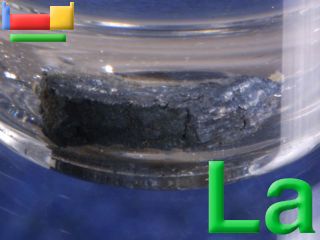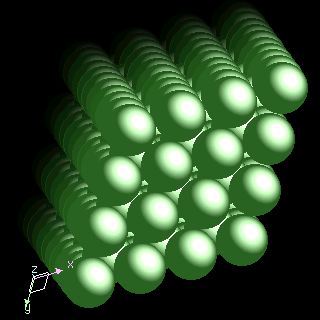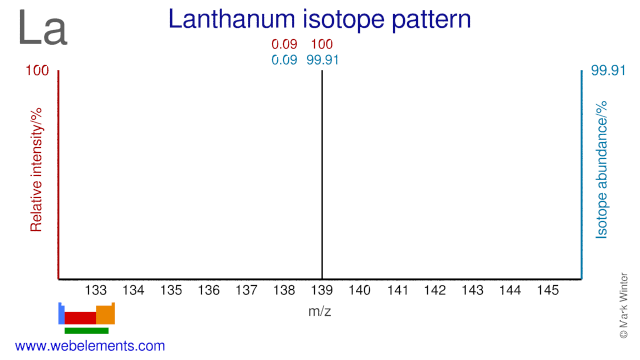Lanthanum - 57La: the essentials
- Name: lanthanum
- Symbol: La
- Atomic number: 57
- Relative atomic mass (Ar): 138.90547 (7) g [see note g]
- Standard state: solid at 298 K
- Appearance: silvery white
- Classification: Metallic
- Group in periodic table:
- Group name: Lanthanoid
- Period in periodic table: 6 (lanthanoid)
- Block in periodic table: f
- Shell structure: 2.8.18.18.9.2
- CAS Registry: 7439-91-0
Lanthanum atoms have 57 electrons and the shell structure is 2.8.18.18.9.2. The ground state electronic configuration of neutral lanthanum is [Xe].5d1.6s2 and the term symbol of lanthanum is 2D3/2.
Lanthanum: description
Lanthanum is silvery white, malleable, ductile, and soft enough to be cut with a knife. It is one of the most reactive of the rare-earth metals. It oxidises rapidly when exposed to air. Cold water attacks lanthanum slowly, and hot water attacks it much more rapidly. The metal reacts directly with elemental carbon, nitrogen, boron, selenium, silicon, phosphorus, sulphur, and with halogens. It is a component of, misch metal (used for making lighter flints).

This sample is from The Elements Collection, an attractive and safely packaged collection of the 92 naturally occurring elements that is available for sale.
Lanthanum: physical properties
Density of solid: 6146 kg m-3
Molar volume: 22.39 cm3
Thermal conductivity: 13 W m‑1 K‑1
Lanthanum: heat properties
Melting point: 1193 [920 °C (1688 °F)] K
Boiling point: 3743 [3470 °C (6278 °F)] K
Enthalpy of fusion: 20.5 kJ mol-1
Lanthanum: atom sizes
Atomic radius (empirical): 195 pm
Molecular single bond covalent radius: 180 (coordination number 3) ppm
van der Waals radius: 298 ppm
Lanthanum: electronegativities
Pauling electronegativity: 1.10 (Pauling units)
Allred Rochow electronegativity: 1.08 (Pauling units)
Mulliken-Jaffe electronegativity: (no data)
Lanthanum: orbital properties
First ionisation energy: 538.09 kJ mol‑1
Second ionisation energy: 1079.18 kJ mol‑1
Third ionisation energy: 1850.33 kJ mol‑1
Lanthanum: abundances
Universe: 2 ppb by weight
Crustal rocks: 34000 ppb by weight
Human: (no data) ppb by weight
Lanthanum: crystal structure

Lanthanum: biological data
Human abundance by weight: (no data) ppb by weight
Lanthanum has no biological role.
Lanthanum: uses
Lanthanum: reactions
Reactions of lanthanum as the element with air, water, halogens, acids, and bases where known.
Lanthanum: binary compounds
Binary compounds with halogens (known as halides), oxygen (known as oxides), hydrogen (known as hydrides), and other compounds of lanthanum where known.
Lanthanum: compound properties
Bond strengths; lattice energies of lanthanum halides, hydrides, oxides (where known); and reduction potentials where known.
Lanthanum: history
Lanthanum was discovered by Carl Gustaf Mosander in 1839 at Sweden. Origin of name: from the Greek word "lanthanein" meaning "to lie hidden".Lanthanum: isotopes

The two isotopes of Lanthanum do not appear to have many applications. Only La-139 is used for the production of the medical radioisotope Ce-139.
Lanthanum: isolation
Isolation: lanthanum metal is available commercially so it is not normally necessary to make it in the laboratory, which is just as well as it is difficult to separate it from as the pure metal. This is largely because of the way it is found in nature. The lanthanoids are found in nature in a number of minerals. The most important are xenotime, monazite, and bastnaesite. The first two are orthophosphate minerals LnPO4 (Ln deonotes a mixture of all the lanthanoids except promethium which is vanishingly rare) and the third is a fluoride carbonate LnCO3F. Lanthanoids with even atomic numbers are more common. The most comon lanthanoids in these minerals are, in order, cerium, lanthanum, neodymium, and praseodymium. Monazite also contains thorium and ytrrium which makes handling difficult since thorium and its decomposition products are radioactive.
For many purposes it is not particularly necessary to separate the metals, but if separation into individual metals is required, the process is complex. Initially, the metals are extracted as salts from the ores by extraction with sulphuric acid (H2SO4), hydrochloric acid (HCl), and sodium hydroxide (NaOH). Modern purification techniques for these lanthanoid salt mixtures are ingenious and involve selective complexation techniques, solvent extractions, and ion exchange chromatography.
Pure lanthanum is available through the reduction of LaF3 with calcium metal.
2LaF3 + 3Ca → 2La + 3CaF2
This would work for the other calcium halides as well but the product CaF2 is easier to handle under the reaction conditions (heat to 50°C above the melting point of the element in an argon atmosphere). Excess calcium is removed from the reaction mixture under vacuum.
